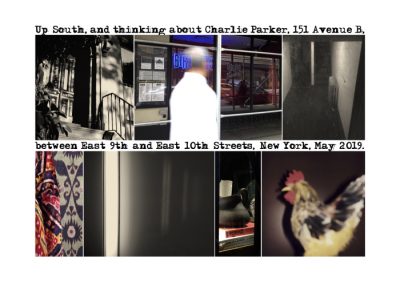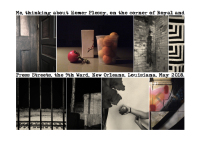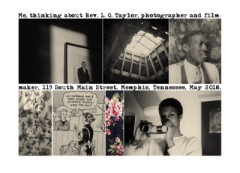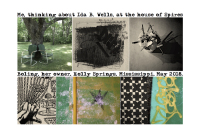.
.

.
“Thinking About Charlie Parker” .2019
.
From the series Pastoral Scenes of the Gallant South
Archival inkjet print, 4½ x 6½ inches, framed to 14 x 14 inches
.
.
___
.
.
The artist comments about this piece:
…..Moving “Up South” in the Pastoral Scenes of the Gallant South series, “Thinking about Charlie Parker” comes out of a recent visit to New York, and is an homage to the musician. Between 1950 and 1954 (a year before his death), Charlie Parker lived with Chan Richardson in the ground-floor apartment of 151 Avenue B. Facing the east side of Tompkins Square Park, the building itself is striking: a rare example of a row house built in the Gothic Revival style. Parker’s four-year stay in this downtown apartment would be the longest period he spent at any one address while living in New York. He and Chan would have two children here, although in March 1954 his three-year-old daughter Pree would die of congenital heart failure, a tragedy, some would argue, from which Bird never recovered.
…..The piece leads with an image of the stoop and front door of the house. I was in the Lower East Side early on a spring evening, just when there was great light hitting the northwest-facing front of #151, casting tree shadows. As I have noted, Bird and Chan occupied the ground floor apartment (they had a garden), but unlike the ground-floor frontage, the grand stoop and impressive front door make a statement, and do justice to the man.
…..Similarly, I know that the West 44th Street Birdland depicted in my piece is the third incarnation of the original club, but I wanted that neon sign. I also wanted a passerby to partially obscure the sign, so that the statement of the image is a little more subtle. The scaffolding covering the façade of the building also does interesting things visually, echoing the breaks between other images in the piece, and nicely breaking up and framing this image, not least the reflection of the street (including, for heaven’s sake, a glimpse of a yellow cab!).
…..I do not wish to say.too.much more about this piece, however – about the bones, sinews, and other connective tissue that hold this photo-narrative together.
…..In one image, the book entitled.“Protest”.is perhaps a nod to the revocation of Parker’s cabaret card by a corrupt, puritanical, and racist NYPD. “Protest”. sits atop a copy of “Soul of a Nation,” the catalog of a recent exhibition subtitled .“Art in the Age of Black Power.”. The title “Soul of a Nation” is apt.
…..And perhaps that is a yardbird that closes the narrative of this piece.
…..Otherwise, as always, I invite the viewer/reader in to find their own narrative within this piece.
.
For complete details about the purchase of any of these pieces, you are welcome to contact the artist at. [email protected]
You can visit his website by clicking here
.
.
Other photo narratives in this series
.
.
“Thinking About Robert Johnson”
.
.

.
.

Click here to view “Me, Thinking About Rev. L.O. Taylor”
.
___
.
.
photo by Jacqueline Ramirez

.
Born and educated in England, Charles Ingham moved to California in 1982. He has always been interested in hybrid forms and the intersection of literature and the visual arts, his photography often seeking to transgress the traditional boundaries separating the verbal and the visual.
Ingham lives in San Diego and shows his work at Distinction Gallery in Escondido. His work may also be found at his website: charlesingham.com
.
.
.

























